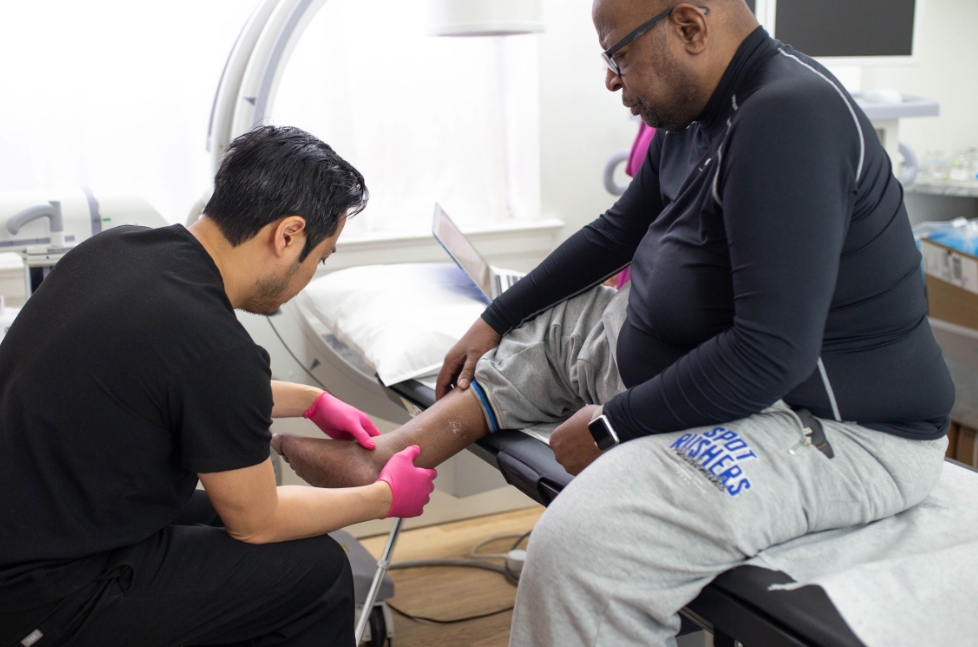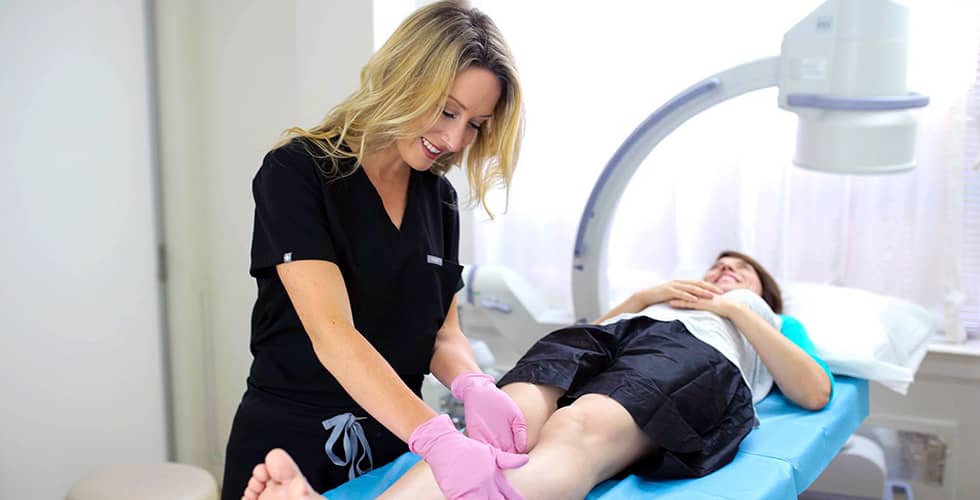Summary of varicose vein treatment in Suffolk County, Long Island.
Dr. Caroline Novak and Dr. Kamran Saraf are the best Long Island vein specialists. Dr. Novak is a board-certified vascular surgeon specializing in the latest minimally invasive varicose vein treatments, including radiofrequency ablation, endovenous laser ablation, and ambulatory phlebectomy. Dr. Novak currently serves as the medical director at Vein Treatment Clinic, one of the most reputable 5-star rated vein centers for varicose vein treatment in Suffolk County. VTC Long Island is located on the Montauk Highway in West Islip, bordering Suffolk County and Nassau County.

Dr. Novak firmly believes that patients should have all the information necessary regarding their varicose vein treatments. This article’s primary goal is to provide accurate and medically-sound information on vein therapy and spider vein removal in Long Island. To that end, we provide a step-by-step overview of what you can expect in the best state-of-the-art vein centers in Long Island. The following is an overview of the varicose vein treatment process:
- Step 1: The Long Island vein specialists diagnose the root cause of your leg pain, spider veins, and other vein problems.
- Step 2: The Long Island vein specialists curate a minimally invasive vein therapy plan.
- Step 3: Minimally invasive varicose vein treatments for the underlying vein disease.
- Step 4: Minimally invasive treatments for spider vein removal.
- Step 5: Discussion of post-treatment care, including compression stockings.

Step 1: The Long Island vein specialists diagnose the root cause of your leg pain, spider veins, and other vein problems.
When you schedule a consultation with the best Long Island vein specialists, they’ll take you through a thorough diagnostic process. During the initial consultation, the vein doctors will discuss your symptoms, review your medical history, and examine your leg veins. They’ll look for signs and symptoms of chronic venous insufficiency, a dangerous circulatory disorder wherein your vein valves collapse and blood accumulate in your leg veins, leading to spider veins, varicose veins, leg pain, restless leg syndrome, and other vein problems.
After the initial consultation, the vein doctors will administer Duplex Ultrasound, one of the best vascular imaging tests. The vascular imaging test will reveal the direction of the blood flow in your leg veins. Vein disease causes blood to flow backward in your leg veins — they use that information to determine if you’re suffering from underlying chronic venous insufficiency. The vascular imaging test also reveals the offending saphenous vein causing all the problems. The diagnostic process is necessary to curate a minimally invasive treatment plan.
Step 2: The Long Island vein specialists curate a minimally invasive vein therapy plan.
After the diagnosis, the vein doctors will discuss your minimally invasive vein therapy options. If you’re suffering from underlying vein disease, they’ll recommend radiofrequency ablation, endovenous laser ablation, or VenaSeal. If you have superficial varicose veins and spider veins without underlying vein disease, they’ll recommend sclerotherapy or ambulatory phlebectomy. The best Long Island vein specialists provide all the necessary information about the treatments, including the possibility of insurance coverage, enabling you to make an informed and educated decision.
Step 3: Minimally invasive varicose vein treatments for the underlying vein disease.
As mentioned previously, radiofrequency ablation, endovenous laser ablation, and VenaSeal are the best minimally invasive vein therapy options. During these procedures, the vein doctors deliver thermal energy, laser energy, or vein glue into the diseased saphenous vein via a catheter, laser fiber, or injection. Thermal energy (radiofrequency ablation) and laser energy (endovenous laser ablation) collapse the problematic saphenous vein. Medical-grade adhesive (VenaSeal) fuses the diseased vein’s walls, turning it into scar tissue. However, all minimally invasive varicose vein treatments produce the same results — they neutralize the diseased leg veins, allowing blood to flow to healthier veins, restoring smooth blood circulation.
Step 4: Minimally invasive treatments for spider vein removal.
Minimally invasive varicose vein treatments address the underlying diseased saphenous vein but not the superficial varicose veins and spider veins on the skin’s surface. After the problematic vein is removed, the vein specialists use sclerotherapy or ambulatory phlebectomy to remove the superficial leg veins. Ambulatory phlebectomy involves removing the superficial varicose veins through incisions on the skin’s surface. Sclerotherapy is a spider vein removal process that involves the injection of a medicine called sclerosant into the spider veins, fusing their vein walls to restore smooth blood circulation to the heart. Over time, the spider veins harden into scar tissues that get absorbed by the body, fading away from the skin’s surface.
Step 5: Discussion of post-treatment care, including compression stockings.
Minimally invasive vein therapy usually concludes within an hour. Once the procedure is complete, you can leave the vein clinic to resume all your daily activities without downtime. The Long Island vein specialists will provide a detailed overview of post-treatment care, including wearing compression stockings, activity limitations, and other recommendations. You must follow the vein doctor’s recommendations precisely to ensure smooth and effective recovery. Other than a few simple post-treatment guidelines, you can resume all your daily activities without interruption. In fact, most patients seek varicose vein treatment during their work lunch break, allowing them to fit the treatment into a busy schedule.
Vein Treatment Clinic is one of the most reputable vein centers in Long Island. For more information on the vein therapy process, please schedule a consultation with our Long Island vein specialists today.
To learn more about the different options for spider and varicose vein treatment, please visit https://www.veintreatmentclinic.com/vein-treatment/. Our accredited vein centers offer all of the latest technology, and our accomplished and compassionate vein experts will create a custom treatment plan tailored to your individual needs. We have locations in New York, Long Island, New Jersey, California, and Texas.









